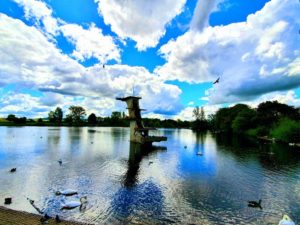Coate Water Art Deco style concrete diving platform given listed status
Coate Water diving platform
The now-defunct 1935 Art Deco style diving platform at Coate Water invokes a fair amount of nostalgia in me. As a child, we sometimes visited Langold Lake (5 miles the ‘other’ side of Worksop). This was a large country park thing – my memories are hazy as it was MANY years ago now. But I recall a swimming lake with a diving platform in it.
Now I’m not saying that the diving platform there was exactly like the one at Coate Water, but the whole thing of the lake and the swimming is evocative. There was also a childrens’ outdoor bathing pool at Langold and getting to go in there was an enormous treat.
Listed buildings
So it’s interesting to see that Historic England have granted Swindon’s 1930s concrete diving platform Grade II listed status.
They state the following reasons for listing the 1935 diving platform:
- Rarity: it is one of only four inter-war concrete diving platforms known to survive in England;
- Architectural and technical interest. It’s a good example of a 1930s re-enforced concrete diving platform. The design features an elegant, cantilevered design constructed to the latest technical innovations to achieve an optimal diving performance;
- Historic interest – unlike most diving platforms, it’s associated with a lake (reservoir)landscaped to provide important outdoor sport and leisure facilities in Swindon during the 19th C and early 20th C.
- Degree of survival: despite the loss of its railings it has survived mostly intact.
The Borough surveyor, JBL Thompson, completed the design in 1935. A year earlier Thompson designed the Art Deco style concert bowl for Swindon’s Town Gardens.
Fancy Diving
The Historic England website gives us some fascination information about the diving platform:
The commemorative booklet records that the official opening of the diving platform took place on 22 June 1935. During the ceremony, the diver, Miss Cicely Cousins (later that year became the national diving champion) gave a demonstration of ‘fancy diving.’ Hot on her diving heels were exhibitions by Les and Bram Tomkins.
The new platform, it seems, had full compliance with the safety regulations laid down by the Federation Internationale de Natation Amateur (FINA). Ergo, the wisdom was that here Swindon had the safest platform available at the time.
FINA was founded in 1908 and continues to be the international governing body of swimming, water polo, diving, synchronised swimming and open water swimming.
I rather like the idea of the ‘fancy diving’ by Miss Cicely Cousins – I would like to have seen that!
The shape of the diving tower at Coate Water meant that the boards could be staggered so as to give sufficient headspace for the diver. And the varying platform heights also allowed for all year round diving, taking account of the changing water levels.
A bit about Coate Water
I’ve written about the Coate Water miniature railway here. And the Coate Water arboretum I featured in my guide book. But here’s a bit about Coate Water itself.
Coate Water started life in the early 1820s as a headwater tank created by the Wilts and Berks Canal company. A stream known as the Dorcan fed it.
The reservoir and landscape around it had a huge influence on the writings of Richard Jefferies (1848-1887). Jefferies entered this world at the nearby Coate Farm – now the Richard Jefferies museum.
From the late C19 there was boating on the water at Coate. By 1900 a number of boathouses had sprung up at the north end of the reservoir.
1921 saw the erection of a wooden predecessor to the concrete one at the lake’s north end. It was surrounded by a swimming and diving area separated from the lake’s main body by timber boards.
By the 1930s the site featured a small Art Deco style outdoor bathing pool and fountain – now long gone. As is the children’s paddling pool – there’s now a splash park on that site.








Angela, I remember when I was a young child my grandparents used to come down from London for a few days, and I distinctly remember Coate Water, with the swimmers diving into the lake, it was a real feature then with the bathers sat dangling their legs over the platforms, it really hasn’t changed at all since then, or probably before. There was another little place they used to take me that was the field from Churchwalk North in Rodbourne Cheney, and into the fields leading to Haydon Wick, a footpath ran through the centre of the field, with seating positioned at various intervals, they used to sit and watch while I played in the Dew pond trying to catch newts and sticklebacks, blimey that’s going back a few years now.